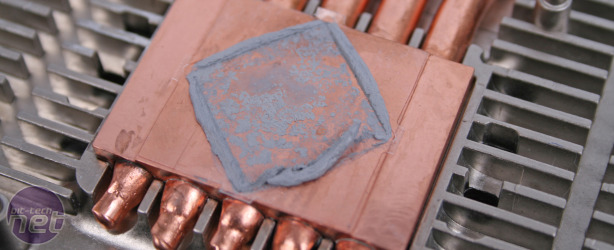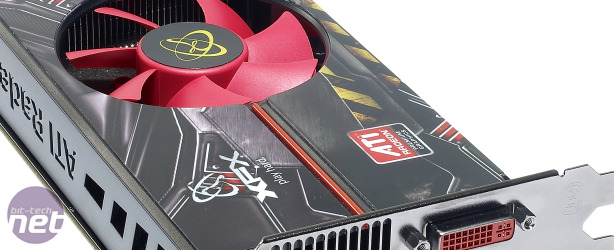
Results Analysis
We’ve had variable results with pre overclocked graphics cards: the majority are damp squibs when it comes to performance gains, and those that do show big performance gains are priced out of the reach of mere mortals. The XFX HD 5870 Black Edition continues this trend, showing only a small improvement over a stock-clocked card.The card destroyed our Dirt 2 benchmark, getting playable results even at 2,560 x 1,600 with 4x AA, but this is a feat that a standard HD 5870 is also capable of. While the Black Edition was 4-8 per cent quicker than the stock card, the overclock wasn’t enough to allow the XFX card to compete with a GeForce GTX 480 in this test. The fortunes of ATI and Nvidia were reversed dramatically in our STALKER: Call of Pripyat testing, and XFX’s ‘family jewels’ comfortably beat the GTX 480 by 5-10fps (when looking at the crucial minimum frame rates). Again, the problem for the Black Edition is that it failed to pull out a meaningful lead over the standard HD 5870, with the results at 1,920 x 1,200 and 1,560 x 1,600 showing only a 1-2fps difference between the two cards.
We were hopeful that the Black Edition could distinguish itself more in our Crysis tests, as the game is a renowned resource hog and should be able to make full use of XFX’s overclock. Our hopes were partially fulfilled, as the XFX card produced 2-3fps more than a stock HD 5870 at 1,680 x 1,050. As the resolution increased, this lead slimmed however, with essentially identical results from the Black Edition and standard HD 5870 at 2,560 x 1,600. The two Radeons traded blows with the GTX 480 throughout the testing, with the ATI cards coming out on top when running the game without AA and the GTX 480 stretching out a lead when AA was enabled.
The story continued in our Bad Company 2 testing, where at every setting apart from 1,680 x 1,050 with no AA the Black Edition was slightly faster than a standard HD 5870 by 1-3fps, but was noticeably slower than the GTX 480.
Power consumption and temperatures for the Black Edition were broadly in line with what we expected, drawing as it did slightly more than a stock-clocked HD 5870 card and significantly less than the Fermi-based GTX 480 when the cards were under load. XFX’s overclock added only 4-7W to our PC’s total power draw compared to the standard HD 5870, while the GTX 480 increased the power draw by between 15W and 79W.
The Black Edition ran 1°C hotter than a standard HD 5870 when idle, but 11°C cooler when under load, showing that XFX’s custom cooler works well. However, it was also distinctly louder than the reference cooler, and to our ears had a more annoying high-pitched tone. The cooler also exhausts most of its hot air back into the case, whereas the stock cooler vents most of its waste heat out of the case.
XFX claims to allow some overclocking headroom in its Black Edition cards, so we cracked out AMD Clock Tool and managed to raise the GPU speed by 30MHz, which gave a minor boost to our benchmark results. We tried to fiddle with the memory too, but any increase above the standard 1.3GHz of the card resulted in artefacts even on the Windows desktop.
Conclusion
As is normally the case with pre-overclocked cards whether to buy this one or not really does comes down to price. We're certainly in favour of having a slight overclock, especially when it’s backed by a warranty, but only if it actually makes the card better value.The XFX HD 5870 Black Edition showed slight performance gains over a stock HD 5870 in all our test games, but it still fell behind the GeForce GTX 480 in most of our benchmarks. However, GTX 480s are retailing for around £420 at the moment, and also run hot, loud and consume a lot of power.
The choice for most of us then, is between this card and a standard HD 5870, which currently cost around £320. The Black Edition costs £10 more, and comes with a free game, those stickers, the guaranteed overclock and the stealth custom cooler, which sounds like a good deal initially. However, while stock cooler of the HD 5870 is quiet and cools the GPU adequately well, the XFX cooler is louder and whinier.
When those stickers have started to peel, and you’re bored of AvP, you’ll still have the irritating cooler of the Black Edition to live with. As it’s highly likely that you’ll be able to overclock any HD 5870 by 50MHz, we’d still get a standard card rather than this Black Edition version.
- Performance
- x
- x
- x
- x
- x
- x
- x
- x
- -
- -
- 8/10
- Features
- x
- x
- x
- x
- x
- x
- x
- -
- -
- -
- 7/10
- Value
- x
- x
- x
- x
- x
- x
- x
- -
- -
- -
- 7/10
- Overall
- x
- x
- x
- x
- x
- x
- x
- -
- -
- -
- 7/10

MSI MPG Velox 100R Chassis Review
October 14 2021 | 15:04










Want to comment? Please log in.